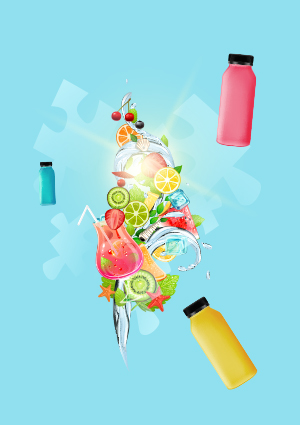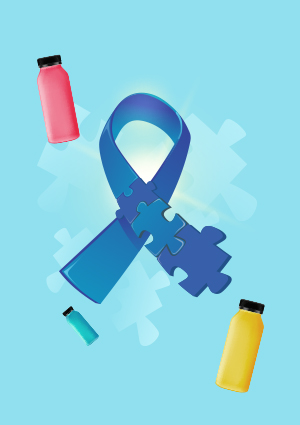#MummaSaysNo
Mumma Says Strike Out Synthetic Colorant!
As a parent, a cook, a caretaker, or a healthcare professional, it’s imperative to know the ill effects of synthetic colorants. Color is a key component to increase the ultimate appetizing value and consumer acceptance towards foods and beverages.1
Synthetic colors have been increasingly used than natural edible colors by food manufacturers to attain certain properties such as low cost, improved appearance, high color intensity, more color stability, and uniformity.1 The use of nonpermitted colours and careless use/overuse of permitted colours are known to cause adverse health effects in humans.2

Inch Closer To Safety By Saying Hello To Safe Colors!
Stay informed, make conscious choices, and embark on a journey towards a healthier, color-filled life.
References
- Dey, S. and Nagababu, B.H. (2022) ‘Applications of food color and bio-preservatives in the food and its effect on the human health’, Food Chemistry Advances, 1, p. 100019. doi:10.1016/j.focha.2022.100019.
- P. G. T. Dilrukshi, Helani Munasinghe, A. Buddhika G. Silva, P. G. S. M. De Silva, "Identification of Synthetic Food Colours in Selected Confectioneries and Beverages in Jaffna District, Sri Lanka", Journal of Food Quality, vol. 2019, Article ID 7453169, 8 pages, 2019. https://doi.org/10.1155/2019/7453169
- Miller, M.D., Steinmaus, C., Golub, M.S. et al. Potential impacts of synthetic food dyes on activity and attention in children: a review of the human and animal evidence. Environ Health 21, 45 (2022).https://doi.org/10.1186/s12940-022-00849-9
- https://www.drugs.com/medical-answers/is-food-coloring-bad-3561219/
- Singh, T. et al. (2023) ‘Natural bio-colorant and pigments: Sources and applications in Food Processing’, Journal of Agriculture and Food Research, 12, p. 100628. doi:10.1016/j.jafr.2023.100628.
- https://www.nafdac.gov.ng/wp-content/uploads/Files/Resources/Regulations/All_Regulations/Food-Additivies-Regulations-2019.pdf
- Arnold LE, Lofthouse N, Hurt E. Artificial food colors and attention-deficit/hyperactivity symptoms: conclusions to dye for. Neurotherapeutics. 2012 Jul;9(3):599-609. doi: 10.1007/s13311-012-0133-x. PMID: 22864801; PMCID: PMC3441937.
- The Canadian Food Inspection Agency conducted a survey on synthetic food colors in various food products. They found that of 391 food samples tested, artificial food colors were detected in 128 (33%). The most commonly detected food colors were Allura Red, Tartrazine, Brilliant Blue FCF, and Sunset Yellow FCF, accounting for 74% of positive results. This survey aimed to gather data on the levels of permitted synthetic food colors in foods available in Canada and to check compliance with Canadian standards and limits [oai_citation:1, Food Colors in Selected Foods – April 1, 2020 to March 31, 2021 - Canadian Food Inspection Agency. https://inspection.canada.ca/food-safety-for-industry/ food-chemistry-and-microbiology/food-safety-testing-reports-and-journal-articles/ food-colours-in-selected-foods/ eng/ 1665086622143/1665086622487
- The information regarding FD&C color additives and their labeling requirements was referenced from the U.S. Food and Drug Administration (FDA) website and the Food Ingredient Facts website. Specifically:
- U.S. Food and Drug Administration (FDA) - [Color Additives Questions and Answers for Consumers] (www.fda.gov) [oai_citation:1,Color Additives Questions and Answers for Consumers | FDA] (https://www.fda.gov/food/color-additives-information-consumers/color-additives-questions-and-answers-consumers).
- Food Ingredient Facts - [Sources of Food Ingredients: Certified Colors] (www.foodingredientfacts.org) [oai_citation:2,Sources of Food Ingredients: Certified Colors - Food Ingredient Facts] ( https://www.foodingredient facts.org/ facts-on-food-ingredients/sources-of- food-ingredients/certified-colors/).
- The information regarding the adverse effects of food colorants on children was referenced from the following websites:
- UC Berkeley Public Health - [New report shows artificial food coloring causes hyperactivity in some kids](publichealth.berkeley.edu) [oai_citation:1,New report shows artificial food coloring causes hyperactivity in some kids - UC Berkeley Public Health] (https://publichealth.berkeley.edu/news-media/research-highlights/new-report-shows-artificial-food-coloring-causes-hyperactivity-in-some-kids/).
- Pediatrics, a publication of the American Academy of Pediatrics - [Food Additives and Child Health](publications.aap.org) [oai_citation:2,Food Additives and Child Health | Pediatrics | American Academy of Pediatrics] (https://publications.aap.org/pediatrics/article/142/2/e20181410/37583/Food-Additives-and-Child-Health).
- The information regarding the hazardous consequences of food color additives on human health was referenced from PubMed, specifically an article titled "Food Color Additives in Hazardous Consequences of Human Health: An Overview" in "Current Topics in Medicinal Chemistry." The article can be found on the PubMed website at [pubmed.ncbi.nlm.nih.gov](https://pubmed.ncbi.nlm.nih.gov) [oai_citation:1,Food Color Additives in Hazardous Consequences of Human Health: An Overview - PubMed] (https://pubmed.ncbi.nlm.nih.gov/36650651/).
References
- Dey, S. and Nagababu, B.H. (2022) ‘Applications of food color and bio-preservatives in the food and its effect on the human health’, Food Chemistry Advances, 1, p. 100019. doi:10.1016/j.focha.2022.100019.
- P. G. T. Dilrukshi, Helani Munasinghe, A. Buddhika G. Silva, P. G. S. M. De Silva, "Identification of Synthetic Food Colours in Selected Confectioneries and Beverages in Jaffna District, Sri Lanka", Journal of Food Quality, vol. 2019, Article ID 7453169, 8 pages, 2019. https://doi.org/10.1155/2019/7453169
- Miller, M.D., Steinmaus, C., Golub, M.S. et al. Potential impacts of synthetic food dyes on activity and attention in children: a review of the human and animal evidence. Environ Health 21, 45 (2022).https://doi.org/10.1186/s12940-022-00849-9
- https://www.drugs.com/medical-answers/is-food-coloring-bad-3561219/
- Singh, T. et al. (2023) ‘Natural bio-colorant and pigments: Sources and applications in Food Processing’, Journal of Agriculture and Food Research, 12, p. 100628. doi:10.1016/j.jafr.2023.100628.
- https://www.nafdac.gov.ng/wp-content/uploads/Files/Resources/Regulations/All_Regulations/Food-Additivies-Regulations-2019.pdf
- Arnold LE, Lofthouse N, Hurt E. Artificial food colors and attention-deficit/hyperactivity symptoms: conclusions to dye for. Neurotherapeutics. 2012 Jul;9(3):599-609. doi: 10.1007/s13311-012-0133-x. PMID: 22864801; PMCID: PMC3441937.
- The Canadian Food Inspection Agency conducted a survey on synthetic food colors in various food products. They found that of 391 food samples tested, artificial food colors were detected in 128 (33%). The most commonly detected food colors were Allura Red, Tartrazine, Brilliant Blue FCF, and Sunset Yellow FCF, accounting for 74% of positive results. This survey aimed to gather data on the levels of permitted synthetic food colors in foods available in Canada and to check compliance with Canadian standards and limits [oai_citation:1, Food Colors in Selected Foods – April 1, 2020 to March 31, 2021 - Canadian Food Inspection Agency. https://inspection.canada.ca/food-safety-for-industry/ food-chemistry-and-microbiology/food-safety-testing-reports-and- journal-articles/ food-colours-in-selected-foods/ eng/ 1665086622143/1665086622487
- The information regarding FD&C color additives and their labeling requirements was referenced from the U.S. Food and Drug Administration (FDA) website and the Food Ingredient Facts website. Specifically:
- U.S. Food and Drug Administration (FDA) - [Color Additives Questions and Answers for Consumers] (www.fda.gov) [oai_citation:1,Color Additives Questions and Answers for Consumers | FDA] (https://www.fda.gov/food/color-additives-information-consumers/color-additives-questions-and-answers-consumers).
- Food Ingredient Facts - [Sources of Food Ingredients: Certified Colors] (www.foodingredientfacts.org) [oai_citation:2,Sources of Food Ingredients: Certified Colors - Food Ingredient Facts] ( https://www.foodingredient facts.org/ facts-on-food-ingredients/sources-of- food-ingredients/certified-colors/).
- The information regarding the adverse effects of food colorants on children was referenced from the following websites:
- UC Berkeley Public Health - [New report shows artificial food coloring causes hyperactivity in some kids](publichealth.berkeley.edu) [oai_citation:1,New report shows artificial food coloring causes hyperactivity in some kids - UC Berkeley Public Health] (https://publichealth.berkeley.edu/ news-media/research-highlights/new-report-shows-artificial-food-coloring-causes-hyperactivity-in-some-kids/).
- Pediatrics, a publication of the American Academy of Pediatrics - [Food Additives and Child Health](publications.aap.org) [oai_citation:2,Food Additives and Child Health | Pediatrics | American Academy of Pediatrics] (https://publications.aap.org/ pediatrics/ article/142/2/e20181410/37583/ Food-Additives-and-Child-Health).
- The information regarding the hazardous consequences of food color additives on human health was referenced from PubMed, specifically an article titled "Food Color Additives in Hazardous Consequences of Human Health: An Overview" in "Current Topics in Medicinal Chemistry." The article can be found on the PubMed website at [pubmed.ncbi.nlm.nih.gov](https://pubmed.ncbi.nlm.nih.gov) [oai_citation:1,Food Color Additives in Hazardous Consequences of Human Health: An Overview - PubMed] (https://pubmed.ncbi.nlm.nih.gov /36650651/).






